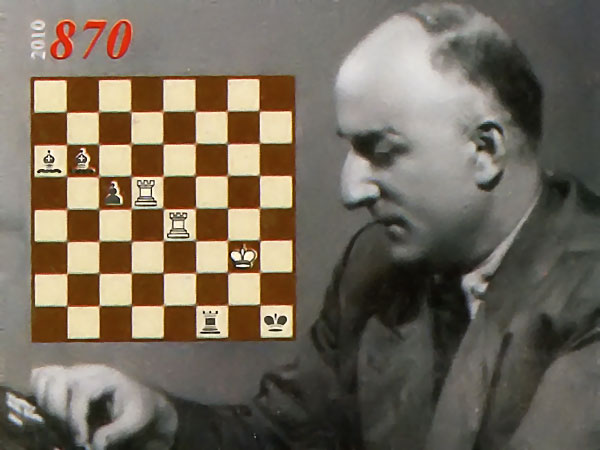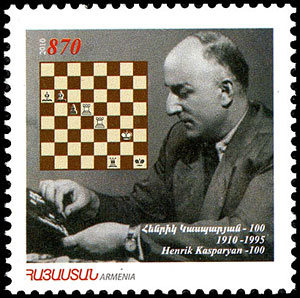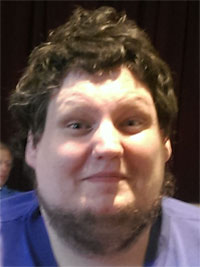



If you want to check my introduction above, you can join almost 400 million viewers to watch Queen - Bohemian Rhapsody, or 190 million viewers of Abba - Dancing Queen. Or you can enjoy the moves of a chess piece that shows great mobility, lighter even than the bishop moving from one end of the board to the other, light-footed delivering aesthetical pleasure in a fierce battle. The game analysis of Edwin Ziegler Adams and Carlos Torre Repetto in New Orleans 1920 springs to mind as the most well-known composition here. Those are the dancing queens we will watch this time.
Our first example is basic in nature, but interesting to watch.
A. Kotov, 64, 2nd Prize, 1975
This light-hearted study is easy to solve: after the pin of the knight is established, Black is left only with the queen to move, which in turn can sacrifice itself, because of stalemate. Since the black queen also needs to protect the knight, however, it will be restricted to the long diagonal. White must dance around that queen, protecting the h-file from it, while Black must prevent White from entering the eighth rank. A cute play unfolds.
The next example — this month’s main featured study — is difficult. Please do not try to understand every variation, but rather enjoy the optical picture. In the solution at the end of this article I have consciously left out almost all variations.
Gady Costeff, EBUR, 1st Prize, 2003
This study was first published in the specialized endgame studies magazine EBUR, which was later merged into "eg". It came with a plethora of additional analysis. It boils down to White being strategically lost, but he has one precise way to draw: by setting up an eternal pin. Creating any additional weakness will lose in one way or another for White, for example playing h2-h3 would allow Black later to intrude with the queen to g3, winning. For the readers willing to know "the truth", i.e. all the supporting variations, a sample from Harold van der Heijden's database "hhdbV" is given as an additional entry in the PGN player with the solutions at the end of this article. I use the HvdH database for most compositions, but add comments and modify variations when necessary, in order not to infringe on copyright and also to give explanations to readers.
 Genrikh Kasparyan, 1910 – 1995, an Armenian, is considered one of the greatest composers of chess endgame studies ever. Kasparyan was awarded the titles of International Judge of Chess Compositions in 1956 and International Grandmaster of Chess Composition in 1972, the first composer to receive this title from FIDE. He was also an active chess player, winning the Armenian championship ten times (from 1934 to 1956, including two ties with future World Champion Tigran Petrosian). He reached the USSR Championship finals four times, but never finished higher than tenth place.
Genrikh Kasparyan, 1910 – 1995, an Armenian, is considered one of the greatest composers of chess endgame studies ever. Kasparyan was awarded the titles of International Judge of Chess Compositions in 1956 and International Grandmaster of Chess Composition in 1972, the first composer to receive this title from FIDE. He was also an active chess player, winning the Armenian championship ten times (from 1934 to 1956, including two ties with future World Champion Tigran Petrosian). He reached the USSR Championship finals four times, but never finished higher than tenth place.
Kasparyan is best known for his compositions. He started with chess problems, mainly three-movers, but soon discovered that his greatest abilities lay in the field of endgame studies. He composed about 600 studies, many on the theme of domination, winning 57 first prizes. He won the USSR Composing Championship several times.
Postal stamp above, "Birth Centenary of Henrik Kasparyan", was issued in Armenia on his 100th anniversary on February 27, 2010. The diagram shows a Kasparian study from L'Italia Scacchisticca, 1984, with the solution 1.Re6 Bc7+ 2.Kh4 Bc4 3.Rxc5 Bd8+ 4.Kg3 Rg1+ 5.Kf3 Rf1+ 6.Kg3 Bxe6 7.Rh5+ Kg1 8.Rh1+ Kxh1 stalemate. Unfortunately it is cooked, because of an additional solution 1.Re7, found by Mario Guido Garcia. However, this was not publically known when the stamp was issued. You can analyse the study on our JavaScript board at the end. Information: Wikipedia.
Genrikh Kasparyan, Shakhmaty v SSSR, 1st Prize, 1935

|
|
 |
About the author
|